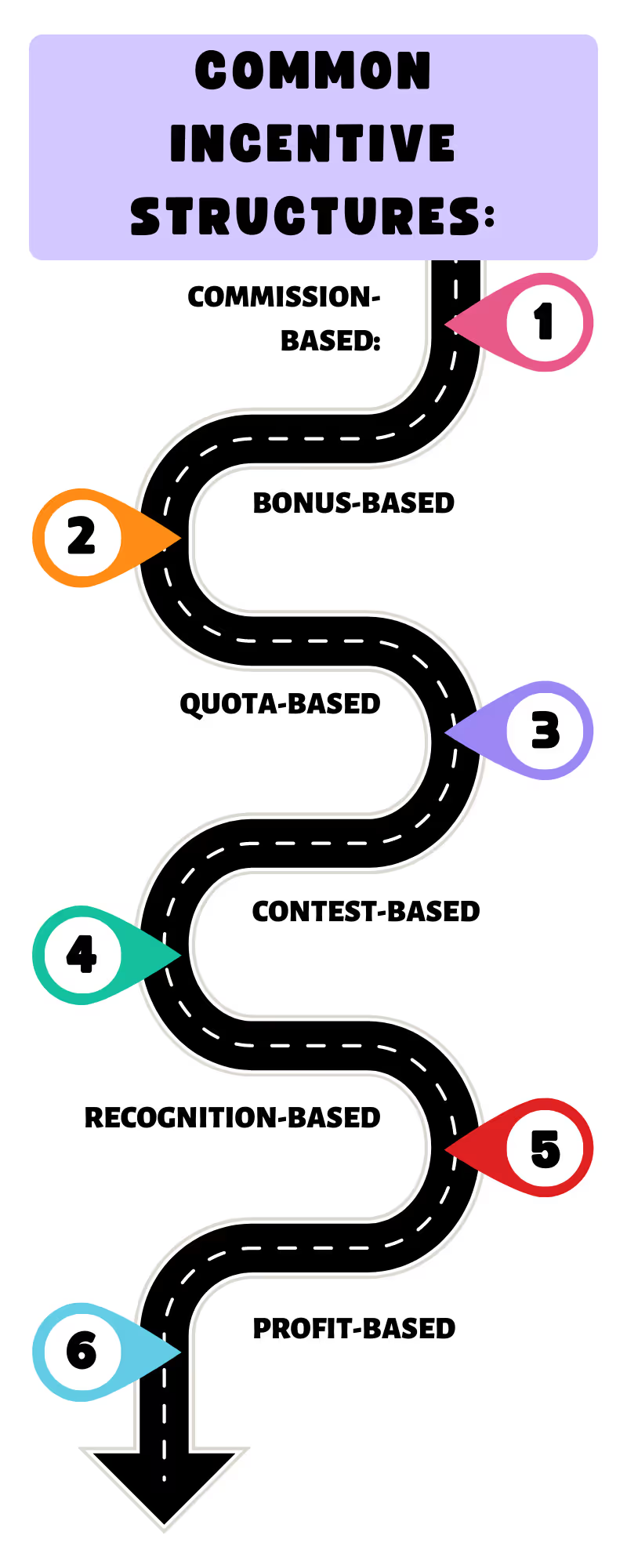
Blog
Building Incentive Structures for Optimal Performance
May 18, 2023


Key Insights
Motivating employees is a critical component of running a successful business.
A well-designed incentive structure can help increase productivity, engagement, and overall job satisfaction.
However, designing an effective incentive structure is not always straightforward. It requires an understanding of the business's goals, the employee's motivation, and the available resources.
In this blog, we will discuss the key elements of an effective incentive structure and provide some tips for designing an optimal program.
What is an Incentive Structure?
An incentive structure in sales refers to the rewards and compensation that are offered to salespeople based on their performance.
Sales performance management is a comprehensive system that is designed to motivate sales representatives and optimize their performance to achieve specific goals, such as meeting or exceeding sales targets, generating new business, or retaining existing customers.
To create effective sales incentive programs within the sales pipeline funnel, it is crucial to align the goals of the salesperson with those of the organization. When the primary objective is to enhance sales revenue, the incentive structure should motivate sales representatives to drive new business and boost the average order value.
Incentives can take many forms, including bonuses, commissions, profit sharing, stock options, or non-monetary rewards such as recognition, promotions, or additional time off.
The structure of the incentive plan should be clear and transparent, with specific goals and rewards outlined so that salespeople know exactly what they need to do to achieve their targets.
It's important to note that an effective incentive structure should be based on a balance of both short-term and long-term goals, including retention tracking. While it's important to reward salespeople for hitting their targets in the short-term, it's also essential to encourage behaviors that will benefit the organization in the long-term, such as building relationships with customers and focusing on customer satisfaction.
In addition, diversifying your incentive structure with group and individual incentives will also bring in team coordination and individual achievements simultaneously.
To achieve your long-term goals, annual incentive plan examples can be a good solution. Read more about it: What are Annual Incentive Plans, Everything you Need to Know.

Why is your Incentive Structure important?
Your incentive structure motivates salespeople to perform at their best and achieve their goals, aligning with the principles of management by objectives (MBO). By providing rewards or incentives for meeting or exceeding sales targets, companies can encourage their sales teams to work harder and more effectively.
A well-designed incentive structure can foster alignment between the sales team's goals and the company's objectives, resulting in heightened productivity and revenue. When salespeople perceive that their efforts are acknowledged and rewarded, it cultivates a sense of engagement and commitment towards attaining the company's targets.
Moreover, an incentive structure can also help retain talented salespeople by providing them with the opportunity to earn more based on their performance. This can help create a sense of loyalty among sales staff, as they feel valued and rewarded for their hard work.
Therefore, having this framework is critical for driving sales performance and achieving business objectives. It helps motivate salespeople to perform at their best, aligns the goals of the sales team with those of the company, and creates a sense of loyalty among sales staff.
Common Incentive Structures:

There are various types of sales incentive structures that companies use to motivate their sales teams to achieve higher sales targets. Here are some common types of sales incentive structures:
- Commission-Based: This is a widely used sales compensation plan where salespeople receive a percentage of the revenue generated from their sales. Under this scheme, the commission increases proportionally with higher sales volumes.
- Bonus-Based: This incentive scheme rewards salespeople with a bonus for achieving specific sales targets or goals. For example, a salesperson may receive a bonus for reaching a certain sales target within a specified time frame.
- Quota-Based: In this scheme, salespeople are assigned a quota, or a specific sales target, to achieve within a given period. If they achieve the quota, they receive a reward.
- Contest-Based: Sales contests are another popular incentive scheme, where salespeople compete against each other to win a prize. The prize may be a cash reward, a vacation package, or any other incentive that motivates the sales team.
- Recognition-Based: Salespeople are often motivated by recognition, so companies may offer incentives that recognize their achievements. For example, a company may publish a leaderboard of its top-performing salespeople or offer awards for outstanding sales performance.
- Profit-Based: This incentive scheme rewards salespeople based on the profitability of their sales. The more profitable their sales are, the higher the reward.
It is important to remember that the right type of sales incentive structure will depend on the company's goals and objectives, as well as the preferences and motivations of the sales team, which often revolve around sales target achievement.

6 Steps to Creating Effective Incentive Pay Plans

1. Eligibility
Who gets the bonus? Figure out who qualifies for the incentive. Is it everyone, just salespeople, or specific departments? Make sure it's clear who can earn extra money.
2. Performance Measures
What do people need to do to earn the bonus? Decide what actions or results will be rewarded. Is it sales numbers, customer satisfaction, or something else? Make sure the goals are clear and achievable.
3. Pay Mix
How much of the bonus is cash, and how much is something else? Decide if the bonus will be all cash, or if you'll offer other rewards like extra vacation time or gift cards. Mix it up to keep people interested.
4. Total Target Cash Value
How much money is available for bonuses? Set a budget for the total amount of bonus money you'll give out. This helps control costs and ensures fairness.
5. Payout Mechanics
How will people get their bonus? Decide when and how bonuses will be paid out. Will it be a lump sum at the end of the year, or smaller payments throughout the year? Make it clear so people know what to expect.
6. Payout Frequency
How often will bonuses be paid out? Determine how often you'll give out bonuses. Will it be yearly, quarterly, or monthly? Choose a schedule that motivates people and fits your budget.
It is important to remember that the right type of sales incentive structure will depend on the company's goals and objectives, as well as the preferences and motivations of the sales team, which often revolve around sales target achievement.
High-yielding Sales Incentive Plan Design
#1 Turn-Key Incentive Plans
A turn-key incentive plan is like having a ready-to-go blueprint requiring minimal adjustments. These plans are pre-designed, taking into account industry standards and best practices, so they can be quickly implemented without the need for extensive customization. This approach saves time and resources while ensuring that the plan is effective from day one. Turn-key plans are ideal for companies that want a fast, reliable solution to motivate their sales teams without the hassle of building something from scratch.
#2 Transparency and Accessibility
Transparency and accessibility are the pillars of trust in any sales incentive plan. When salespeople can clearly see how their performance ties to their rewards and have easy access to track their progress, they’re more motivated to reach their targets. This means designing a plan where every detail, like targets, bonuses, and payout schedules, is openly communicated.
#3 Complex Plans Made Easy
Sales incentive plans often need to address multiple objectives, which can lead to complexity. However, a high-yielding plan should simplify this complexity for the sales team. This means breaking down intricate elements into straightforward, easy-to-understand components. For example, instead of overwhelming reps with a matrix of different commission rates, you can use tiered structures or simple visual aids that clarify how they can achieve their goals. By making complex plans easy to grasp, you ensure that salespeople stay focused and motivated, rather than confused or demoralized by the intricacies of the plan.
Incentive Compensation Management Software: A Must-Have
Manual calculations and spreadsheets are a recipe for disaster when it comes to incentive compensation. Errors are inevitable, morale is affected, and your bottom line takes a hit.
Enter Incentive Compensation Management (ICM) software. This powerful tool automates the entire process, from plan design to payout. Imagine accurate calculations, real-time insights, and happy employees.
Why bother with the headache of manual calculations when you can have a system like Kennect handle it all? It's an all-in-one solution that takes the guesswork out of incentives.
Don't let incentive errors undermine your business. Embrace ICM software and enjoy peace of mind with accurate and efficient compensation management.
How to build your Incentive Structure:
- Identify the right metrics: The first step in designing an effective incentive structure is to identify the right metrics to measure performance. The metrics should be aligned with the business's goals and objectives, and they should be measurable, meaningful, and objective. For example, if the goal is to increase sales, the metric could be the number of units sold, revenue generated, or customer satisfaction scores.
- Set realistic targets: Once the metrics are identified, it's important to set realistic targets. The targets should be challenging but achievable, and they should be communicated clearly to the employees. Setting unattainable targets can demotivate employees and lead to a decrease in performance.
- Determine the rewards: The rewards for achieving the targets should be meaningful and relevant to the employees. The sales incentive can be in the form of cash bonuses, gift cards, time off, or other non-monetary benefits such as recognition or career advancement opportunities. It's important to ensure that the rewards are aligned with the business's budget and are sustainable in the long run.
- Communicate the incentive structure: The incentive structure should be communicated clearly and frequently to the employees. The communication should include the metrics, targets, and rewards, as well as the rules and guidelines for the program. It's important to ensure that the employees understand how the program works and how they can earn the rewards.
- Monitor and evaluate the program: Finally, it's important to monitor and evaluate the incentive program regularly. The incentive compensation management plan should be reviewed to ensure that it's achieving the desired results and to make any necessary adjustments. Feedback from the employees should be solicited to understand their perception of the program and to identify any areas for improvement.
In conclusion, designing an effective incentive structure requires careful planning and consideration. The metrics, targets, and rewards should be aligned with the business's goals and resources, and they should be communicated clearly to the employees.
By following these tips, businesses can create an optimal program that motivates employees to perform at their best.
To know more about how Incentive Compensation automation can help you build a data-driven strategy designed to win, book a demo with us!
ReKennect : Stay ahead of the curve!
Subscribe to our bi-weekly newsletter packed with latest trends and insights on incentives.
Thank you! Your submission has been received!
Oops! Something went wrong while submitting the form.
Your data is in safe hands. Check out our Privacy policy for more info














